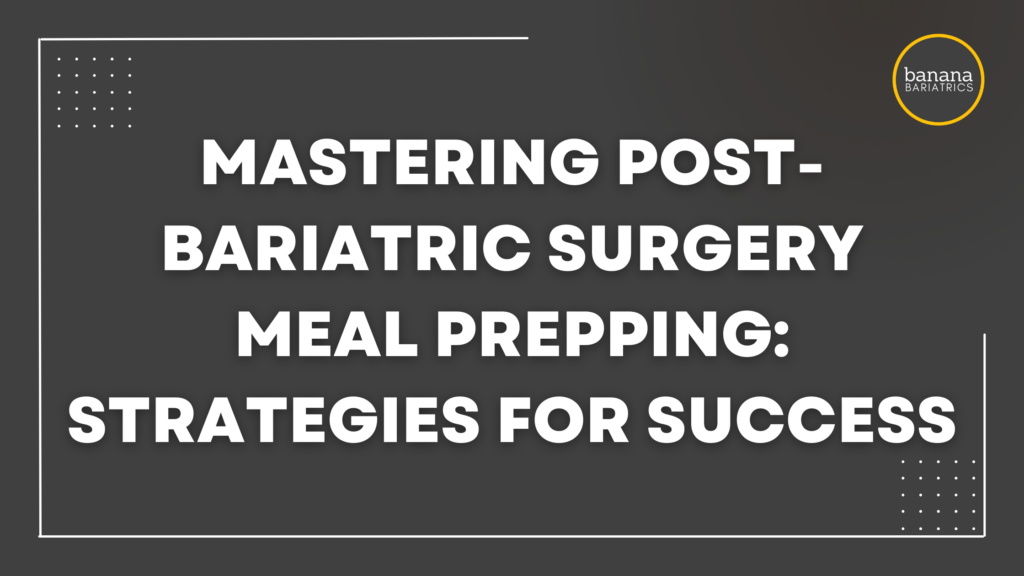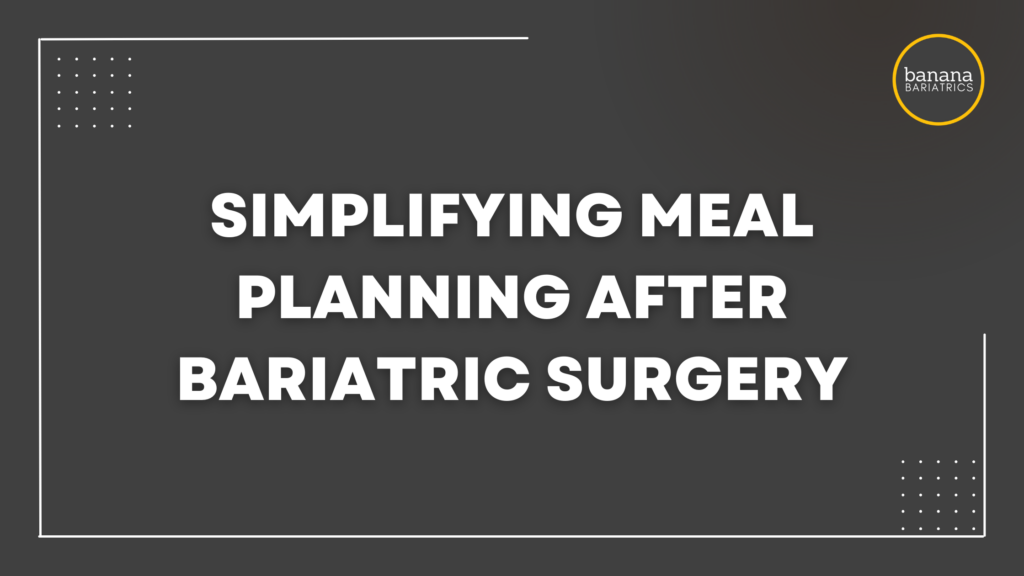Mastering Post-Bariatric Surgery Meal Prepping: Strategies for Success

Life after surgery requires dedication to a healthier lifestyle, especially when it comes to post-bariatric meal prep. Discover effective strategies for seamless and stress-free meal prepping in this week’s blog post.
Mindful Macro-Nutrient Selection
Achieving a balanced plate is key to long-term nutritional success and effective post-bariatric meal prep. When building your plate, be thoughtful of the balance between lean proteins, healthy fats, and carbohydrates. Opt for lean proteins like poultry, fish, well hydrated lean meats, and tofu, while embracing the goodness of healthy fats from sources such as avocados and nuts (as tolerated). Those who have had a gallbladder removal or the gastric bypass, Switch, or SADI may have a hard time tolerating healthy fats in their diet. Aim for fat-free options instead, or include more fibrous non-starchy vegetables and protein to stay fuller for longer. The inclusion of complex carbohydrates, such as whole grains, ensures sustained energy levels throughout the day.
Portion Control Mastery & Emphasis On Hydration
The emphasis on portion control after bariatric surgery is paramount. Embrace smaller, nutrient-dense meals to facilitate efficient digestion and optimize nutrient absorption. Dividing daily intake into several smaller portions ensures a steady release of energy, promoting overall well-being. This can be helpful for those who feel full after a small serving of food. If you are finding yourself fatigued and low energy, ensure you are eating enough throughout the day, are taking your vitamins daily, and are also maintaining adequate hydration. Aim for at least 64 ounces of water daily, waiting at least 30 minutes before and after meals to avoid interference with nutrient absorption. Prioritizing water over sugary beverages significantly reduces carbohydrate and sugar intake, while making it easier for weight loss and weight maintenance.
The Art of Efficient Bariatric Meal Prepping
Efficient batch cooking is a game-changer when it comes to successful meal prepping. By creating a streamlined process of cooking, you can save time, reduce stress, and ensure that you always have nutritious and delicious meals ready to enjoy throughout the week. Make batch cooking a regular part of your weekly routine by choosing a day when you have sufficient time to focus on prepping and cooking. Consistency is key to maintaining an efficient meal prepping routine.
Before starting the batch cooking process, plan a menu for the week. Choose recipes that use similar ingredients to minimize waste and simplify your shopping list. Start with just 1 new recipe to try for the week. If that feels like too much, aim for 1 new recipe per month. Plan your meals in a way that allows you to rotate them throughout the week. This prevents monotony and keeps your taste buds excited while ensuring that meals are consumed before they lose freshness.
Select ingredients that can be used across multiple meals. For example, grilled chicken can be added to salads, lettuce wraps, or served with various sides. This not only adds variety to your diet but also reduces the number of ingredients you need to prep.
Streamline the process of cooking by prepping similar ingredients together. For instance, chop all your vegetables at once, marinate proteins in one go, and cook grains simultaneously. This organized approach saves time and minimizes the need to switch between different tasks.
Utilize your oven and stovetop efficiently by cooking multiple items simultaneously. While a protein is baking in the oven, begin sautéing vegetables on the stovetop. This multitasking approach speeds up the batch cooking process. Consider incorporating time-saving appliances like a slow cooker, Instant Pot, or air fryer into your batch cooking routine. These appliances allow you to prepare large quantities of food with minimal effort and can cut back significantly on time needed for food to cook.
Once your food has cooled, divvy up your food into glass or BPA free storage containers. Ensure you have the right equipment by investing in a variety of high-quality, portion-sized containers. Opt for containers that are microwave and freezer-safe for easy reheating and storage. This also helps in keeping your meals organized. After batch cooking, label each container with the meal name and date of preparation. This ensures you can easily identify and consume meals in a timely manner, preventing food waste. If you’re batch cooking for an extended period, freeze some meals to maintain freshness. Ensure proper packaging to prevent freezer burn, and label containers with reheating instructions.
Fitting Meal Prepping Into A Busy Schedule
When life gets hectic, ensure grab-and-go options are readily available. Keep refrigerated items chilled in an appropriately sized lunch bag or cooler. For on-the-go protein snacks, consider turkey slices with low-fat cheese, hard-boiled eggs, cottage cheese with berries, or plain nuts. Make sandwiches bariatric-friendly by using lettuce wraps or opting for sprouted grain bread for higher fiber and protein.
Staying Prepared On-The-Go
For those with busy schedules, staying prepared on-the-go is crucial. Ensure your pantry is stocked with bariatric-friendly foods that are easy to grab. Keep an appropriately sized lunch bag or cooler with you to maintain the freshness of refrigerated items. Whether you’re at work, driving, or shuttling kids around, having nutritious options readily available will help you stay on track.
Smart Snacking for Busy Lifestyles
Navigating a busy schedule doesn’t mean sacrificing nutrition. Consider pre-made protein packs or “P3” packs, available at grocery stores or easily recreated at home. These packs typically include a meat, cheese, and nuts, providing a convenient and satisfying snack option. Other uncomplicated bariatric-friendly snacks include turkey slices with low-fat cheese and guacamole, hard-boiled eggs, cottage cheese with mashed berries, Greek yogurt without granola, and plain nuts.
Transforming Your Favorites into Bariatric-Friendly Options
If you’re a fan of sandwiches, there are creative ways to make them bariatric-friendly in your post-bariatric meal prep. Swap out traditional bread for lettuce wraps or opt for an open-faced sandwich. Consider using sprouted grain bread for added fiber and protein. Another innovative approach is turning your sandwich or wrap into a bowl, using cauliflower rice as a base. This not only adds variety to your meals but also increases your intake of non-starchy vegetables, aiding in satiety.
Long-Term Success through Consistency
Consistency is key to achieving and maintaining success in your post-bariatric surgery journey. Whether it’s portion control, macro-nutrient balance, or efficient meal prepping, developing consistent habits will contribute to your long-term well-being. Celebrate small victories, stay mindful of your nutritional choices, and make adjustments as needed.
In Conclusion: Thriving in Your Post-Bariatric Lifestyle
Mastering the art of post-bariatric meal prep requires dedication, planning, and adaptability. By incorporating mindful macro-nutrient selection, emphasizing portion control, and efficiently batch cooking, you’re setting yourself up for success. Stay prepared on-the-go with smart snacking options, transform your favorite foods into bariatric-friendly alternatives, and embrace consistency for long-term well-being. Your post-bariatric journey is a transformative path, and with these strategies, you can thrive in your healthier lifestyle.
Need Help Increasing Your Protein Intake After Surgery?
Grab my FREE High Protein Resource below to help you hit those 60g+ of protein a day after bariatric surgery. Our FREE Protein Resource will help you:
- Identify high protein sources from nutrient dense foods
- Understand the exact protein amounts per serving from every food group
- Create easy “grab-and-go” high protein snacks
- Make grocery shopping seamless, with a printable shopping list







Responses